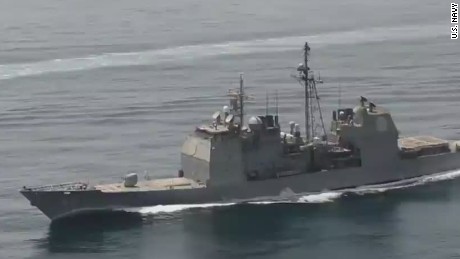An Iranian-flagged vessel targeted a United States Navy destroyer and helicopter in the Gulf of Aden with a laser device multiple times this week, CNN reported Thursday. According to a U.S. defense official, the USS Forrest Sherman was “conducting routine maritime operations” in international waters when its bridge area and the aircraft were targeted.
No damage was reported, and the incidents are being regarded as “harassment from the Iranians.”
The report comes in the wake of a series of confrontations between Iranian naval forces and U.S. and allied vessels in the region. This April, Iran’s Islamic Revolutionary Guard Corps (IRGC) fired on, diverted and boarded the MV Maersk Tigris, a cargo ship that was sailing in international waters under the flag of the Marshall Islands, the defense of which is under the “full authority and responsibility” of the United States.
Michael Singh, managing director of The Washington Institute for Near East Policy, wroteof the seizure in the Wall Street Journal:
These incidents, while troubling, should not be surprising. Iran’s Islamic Revolutionary Guard Corps naval forces routinely engage in reckless behavior. Sometimes these incidents amount to close calls: The U.S. Navy said, for example, that Iranian forces had attempted a similar gambit days before the Tigris was seized last month, and in 2008 a U.S. naval vessel eventually fired warning shots at Iranian naval boats threatening them. Sometimes the Iranians’ behavior results in full-blown international crises, such as Iran’s unprovoked seizure in 2007 of 15 British marines. That such incidents do not occur more frequently is largely due to the professionalism of the U.S. Navy and other services and shipping lines plying the Gulf.
Singh argued that this sustained pattern of aggression by the IRGC is indicative of either Ayatollah Khamenei’s support of the force’s behavior, or his inability to contain it, and that both conclusions have troubling implications for Iran’s willingness and ability to comply with international agreements, including any nuclear accords. The IRGC is estimated to control around a sixth of Iran’s economy, and will benefit substantially from any sanctions relief that accompanies a nuclear agreement.
The seizure of the MV Maersk Tigris came days after the U.S. dispatched an aircraft carrier group to block an Iranian naval convoy suspected of carrying arms for Shiite rebels in Yemen. The convoy, which turned course after the deployment of the American force, would have violated the arms embargo imposed by the United Nations Security Council on Iran-backed Houthi militias and allied factions.
In March, an Iranian surveillance aircraft came unusually close to a Navy helicopter from the USS Carl Vinson in the Persian Gulf, making two passes at the helicopter while it was on a routine patrol. In February, the IRGC sunk a mock U.S. aircraft carrier during military exercises, a year after Iranian state TV broadcast a simulation of Iranian strikes on theUSS Abraham Lincoln and other naval assets in the Persian Gulf.
IRGC leaders have routinely directed threats at American naval forces, with senior commander Ali Fadavi saying in 2014 “that one of the IRGC navy’s operational goals is to destroy the U.S. Navy.”






